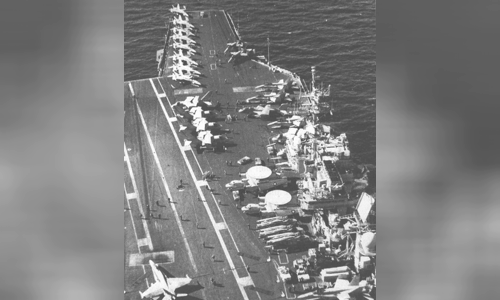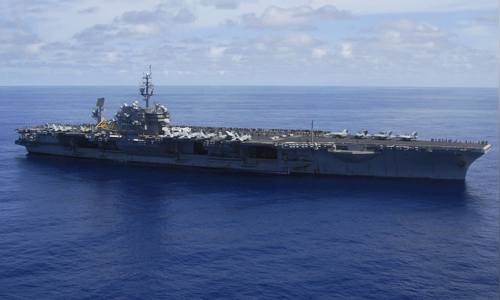The Russian Su-27 fighter hovered on the front of the aircraft carrier USS Kitty Hawk for 40 minutes without being hindered by the lack of readiness of the US battleship.
"On October 17, 2000, a Su-24 and Russian Su-27 fighter jet flew over the front of the aircraft carrier USS Kitty Hawk in the Sea of Japan. This action seemed to have surprised the ship's crew. , not in time to deploy a helicopter to intercept Russian aircraft squadrons, "the United States Naval Heritage and Heritage Command wrote on its official website.

The deck of the USS Kitty Hawk was taken by a Russian pilot on October 17, 2000 Photo: USNI
This is considered a shameful failure of the US Navy when the Russian aircraft squadron circled the bridge of the aircraft carrier USS Kitty Hawk at an altitude of only 60 m without being attacked by any aircraft. carrier hinder.
"The Su-27 and Su-24 squadron flew over our heads at a speed of over 900 km / h. They circled for two more rounds before we could get an EA-6B Prowler electric warplane to start. igniting Su-27 around it like a bear about to eat its prey, Prowler's crew screamed for help before the first F / A-18 fighter left the deck, "an unnamed officer on the radio pointed to. USS Kitty Hawk badge then revealed.
The Russian pilot even took photos of the U.S. aircraft carrier deck, showing chaos as the crew tried to prepare for the fighter jet, and most of the aircraft was in a resting state, unable to take off. The photo was emailed to Russia's USS Kitty Hawk captain by email, before it was published in an internal US Navy magazine in 2003.
Colonel Kevin Wensing, a spokesman for the U.S. Navy Fleet, affirmed that the carrier squadron Kitty Hawk had spotted the Russian aircraft fleet via radar and took appropriate action. However, experts believe that the US aircraft carrier was completely surprised and passive in this incident.

USS Kitty Hawk drills off Japan in 2007 Photo: US Navy
"The deck was clearly ineligible for fighter launch. USS Kitty Hawk took 40 minutes from the order of the sorties until the EA-6B Prowler took off. It was originally unable to intercept and nor a rival of the Russian fighter squad, "historian Mark Turner said.
"Onboard aircraft should have maintained a high combat status and were ready to take off in less than 15 minutes when the aircraft carrier moved in strategic areas near Russia, North Korea and Japan. surprise and not ready to fight at that time, "said a former US fighter fighter pilot deployed in the Sea of Japan.
The incident caused Captain Allen G. Myers to be so stressful that he ordered to remain on duty 24 hours a day, requiring F / A-18 fighters to depart several times to oversee aircraft operating near USS Kitty. Hawk. The Russian Air Force then proceeded to send the aircraft to the aircraft carrier combat group USS Kitty Hawk, but the American fighters had set off to drive away from afar.



 MyleneMylene
MyleneMylene







